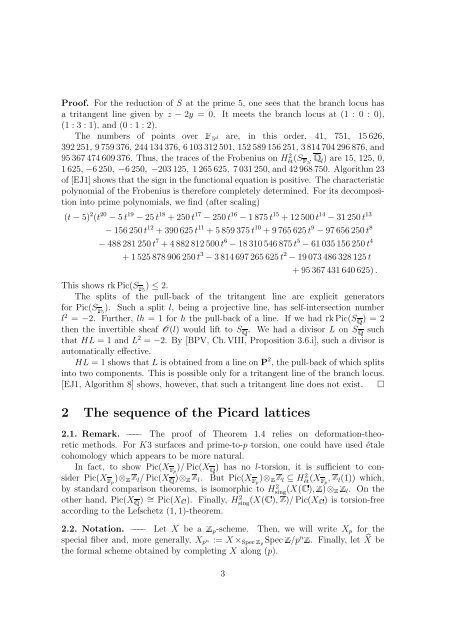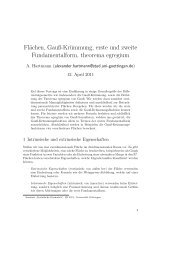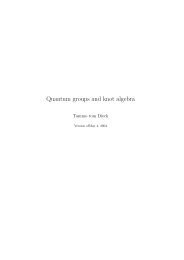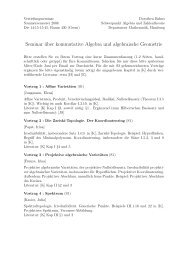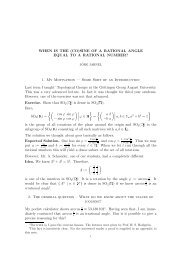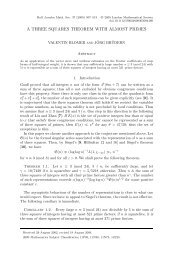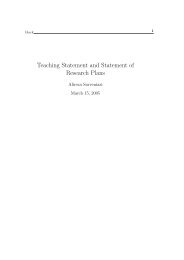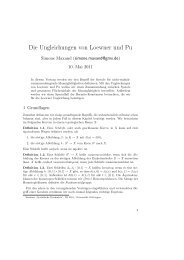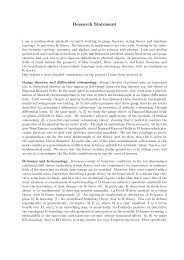The Picard group of a K3 surface and its reduction modulo p
The Picard group of a K3 surface and its reduction modulo p
The Picard group of a K3 surface and its reduction modulo p
You also want an ePaper? Increase the reach of your titles
YUMPU automatically turns print PDFs into web optimized ePapers that Google loves.
Pro<strong>of</strong>. For the <strong>reduction</strong> <strong>of</strong> S at the prime 5, one sees that the branch locus has<br />
a tritangent line given by z − 2y = 0. It meets the branch locus at (1 : 0 : 0),<br />
(1 : 3 : 1), <strong>and</strong> (0 : 1 : 2).<br />
<strong>The</strong> numbers <strong>of</strong> points over5d are, in this order, 41, 751, 15 626,<br />
392 251, 9 759 376, 244 134 376, 6 103 312 501, 152 589 156 251, 3 814 704 296 876, <strong>and</strong><br />
95 367 474 609 376. Thus, the traces <strong>of</strong> the Frobenius on Hét 2 ,Él) are 15, 125, 0,<br />
(S5<br />
1 625, −6 250, −6 250, −203 125, 1 265 625, 7 031 250, <strong>and</strong> 42 968 750. Algorithm 23<br />
<strong>of</strong> [EJ1] shows that the sign in the functional equation is positive. <strong>The</strong> characteristic<br />
polynomial <strong>of</strong> the Frobenius is therefore completely determined. For <strong>its</strong> decomposition<br />
into prime polynomials, we find (after scaling)<br />
(t − 5) 2 (t 20 − 5 t 19 − 25 t 18 + 250 t 17 − 250 t 16 − 1 875 t 15 + 12 500 t 14 − 31 250 t 13<br />
− 156 250 t 12 + 390 625 t 11 + 5 859 375 t 10 + 9 765 625 t 9 − 97 656 250 t 8<br />
− 488 281 250 t 7 + 4 882 812 500 t 6 − 18 310 546 875 t 5 − 61 035 156 250 t 4<br />
+ 1 525 878 906 250 t 3 − 3 814 697 265 625 t 2 − 19 073 486 328 125 t<br />
+ 95 367 431 640 625).<br />
This shows rk ) ≤ 2. Pic(S5<br />
<strong>The</strong> spl<strong>its</strong> <strong>of</strong> the pull-back <strong>of</strong> the tritangent line are explicit generators<br />
for ). Such a split l, being a projective line, has self-intersection number<br />
Pic(S5<br />
l 2 = −2. Further, lh = 1 for h the pull-back <strong>of</strong> a line. If we had rk Pic(SÉ) = 2<br />
then the invertible sheaf O(l) would lift to SÉ. We had a divisor L on SÉsuch<br />
that HL = 1 <strong>and</strong> L 2 = −2. By [BPV, Ch.VIII, Proposition 3.6.i], such a divisor is<br />
automatically effective.<br />
HL = 1 shows that L is obtained from a line on P 2 , the pull-back <strong>of</strong> which spl<strong>its</strong><br />
into two components. This is possible only for a tritangent line <strong>of</strong> the branch locus.<br />
[EJ1, Algorithm 8] shows, however, that such a tritangent line does not exist. □<br />
2 <strong>The</strong> sequence <strong>of</strong> the <strong>Picard</strong> lattices<br />
2.1. Remark. –––– <strong>The</strong> pro<strong>of</strong> <strong>of</strong> <strong>The</strong>orem 1.4 relies on deformation-theoretic<br />
methods. For <strong>K3</strong> <strong>surface</strong>s <strong>and</strong> prime-to-p torsion, one could have used étale<br />
cohomology which appears to be more natural.<br />
In fact, to show Pic(Xp )/ Pic(XÉ) has no l-torsion, it is sufficient to consider<br />
)⊗l/ Pic(XÉ)⊗l. But Pic(Xp Pic(Xp )⊗l ⊆ Hét 2 ,l(1)) which,<br />
(Xp<br />
by st<strong>and</strong>ard comparison theorems, is isomorphic to Hsing(X(),)⊗l. 2 On the<br />
other h<strong>and</strong>, Pic(XÉ) ∼ = Pic(X). Finally, Hsing 2 (X(),)/ Pic(X) is torsion-free<br />
according to the Lefschetz (1, 1)-theorem.<br />
2.2. Notation. –––– Let X be ap-scheme. <strong>The</strong>n, we will write X p for the<br />
special fiber <strong>and</strong>, more generally, X p n := X × Specp Spec/p n. Finally, let ̂X be<br />
the formal scheme obtained by completing X along (p).<br />
3


